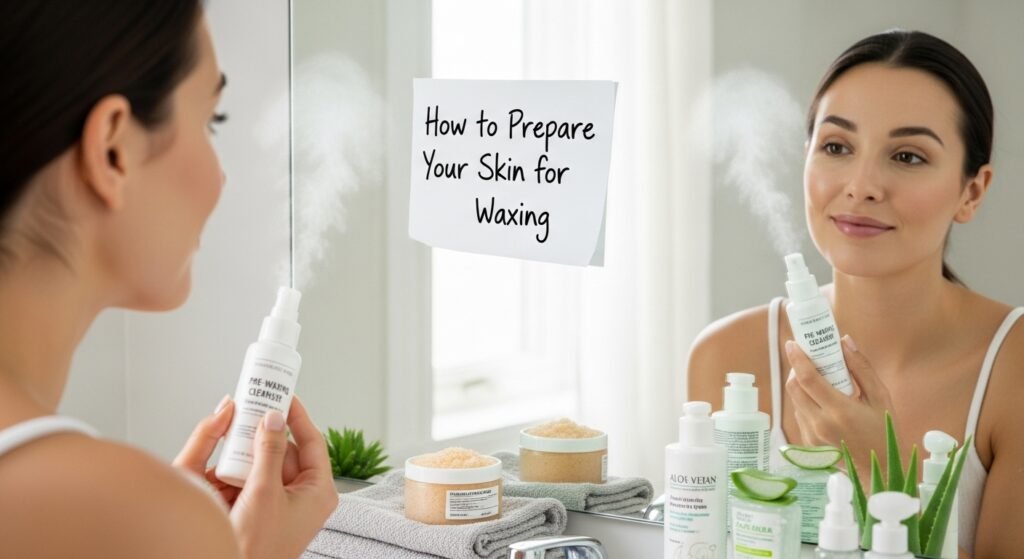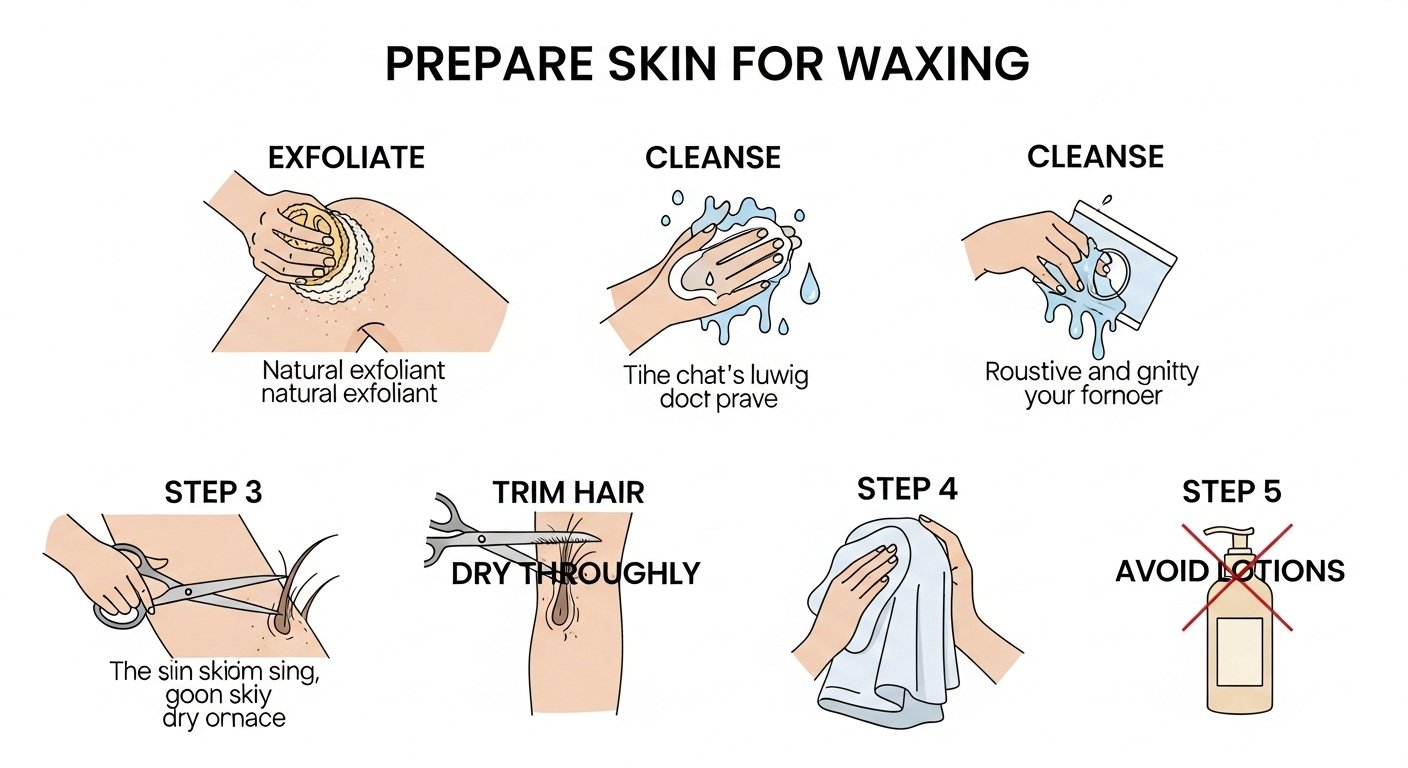How to Prepare Your Skin for Waxing
Featured-Snippet Answer (Quick Summary)
To prepare your skin for waxing, exfoliate 24–48 hours beforehand, keep your skin clean and moisturised in the days leading up, and arrive with dry, product-free skin on appointment day. Let hair grow to about ¼ inch, skip retinoids or AHAs a week prior, and wear loose cotton clothing afterward. Following these steps minimises irritation and helps the wax remove hair cleanly for silky-smooth results.
Why Proper Skin Preparation Matters

Getting waxed isn’t only about hair removal — it’s about protecting your skin barrier and ensuring a clean, smooth result. Proper preparation reduces redness, ingrown hairs, and discomfort while helping your esthetician work more efficiently.
When the hair length, hydration level, and surface condition of your skin are just right, the wax adheres to the hair instead of the skin. That means less pulling, fewer bumps, and a finish that feels softer for longer.
1–2 Weeks Before: Grow & Protect Your Skin
Let the Hair Reach the Ideal Length
For wax to grip properly, your hair should be about a quarter-inch long — roughly the size of a grain of rice. If you’ve been shaving, allow at least 10–14 days of growth before your appointment. This ensures the wax catches even short hairs without breaking them, giving you smoother results.
Pause Strong Actives and Exfoliants
Stop using skincare products that contain Retin-A, retinoids, or AHAs for about a week. These ingredients speed up cell turnover and can make your skin sensitive, increasing the risk of irritation or micro-tears during waxing.
Stay Consistent with Gentle Moisturising
Hydrated skin is flexible skin. Using a fragrance-free lotion each night helps the hair slide out more easily from its follicle. Keep this up until the day before your appointment, but remember to skip lotion on waxing day itself — we’ll get to that later.
Protect from the Sun
Avoid tanning beds and extended sun exposure. Sunburned or heat-stressed skin is fragile and painful to wax. Think of this phase as letting your skin rest and recover so it can handle the waxing process comfortably.
1–2 Days Before: Exfoliate & Hydrate
Gentle Exfoliation for Smooth Results
About 24–48 hours before your appointment, gently exfoliate the area using a mild scrub, exfoliating mitt, or soft brush. The goal is to remove dead skin cells and prevent ingrown hairs, not to scrub harshly.
This step helps the wax adhere to hair, not skin, improving both comfort and efficiency.
Pro Tip: For sensitive areas like the bikini line or underarms, a sugar-based scrub or soft-textured glove works best.
Light Moisture Boost
After exfoliating, apply a thin layer of light, unscented moisturiser to keep the skin supple. Avoid heavy creams that leave a residue. Well-hydrated skin releases hair more easily, which means less tugging during waxing.
Keep Pores Calm
If you’re prone to breakouts or redness, applying a cool compress or gentle aloe gel can soothe the skin the night before. Think of it as priming your skin — balanced, calm, and ready.
Double-Check for Sensitivity
Look over the area for any inflammation, wounds, or irritation. If anything looks inflamed, postpone your appointment until it heals. Healthy skin always reacts better to waxing.
Day of Your Appointment: Cleanse & Calm
Take a Warm Shower
Ten to fifteen minutes in warm water softens hair follicles and opens pores, helping the wax grip hair more effectively. Skip hot water — lukewarm is best to avoid skin flushing.
Skip Lotions, Oils, and Makeup
Arrive with clean, dry skin. Lotions, oils, or body creams form a barrier that prevents wax from adhering properly.
For areas prone to moisture (like underarms), lightly dusting baby powder or talc helps absorb sweat before your esthetician applies wax.
Consider a Pain Reliever
If you have a low pain threshold, taking an over-the-counter pain reliever like ibuprofen 30 minutes before your session can make a noticeable difference.
Avoid Caffeine or Alcohol
Both can increase blood flow to the skin’s surface, making you more sensitive. Opt for water or herbal tea instead to stay hydrated and calm.
Wear Loose, Breathable Clothing
After waxing, friction is your enemy. Choose loose-fitting cotton clothes to reduce irritation and let your skin breathe. Tight clothing can trap heat and cause bumps or ingrown hairs.
Aftercare: Recovery, Hydration & Maintenance
Waxing doesn’t end when you step out of the salon — aftercare is the secret to smooth, bump-free results and healthy skin.
Let Your Skin Rest
For the first 24–48 hours, avoid heavy activity that causes sweat or friction, like intense workouts, saunas, or long hot baths. These can open pores and allow bacteria to enter, leading to breakouts or irritation.
Give your skin space to breathe — literally. Wear loose, breathable fabrics and skip harsh soaps or perfumed products.
Soothe and Hydrate
Use a gentle, fragrance-free moisturiser or aloe vera gel to calm and hydrate the skin. Ingredients like chamomile, cucumber, and witch hazel can help soothe redness naturally.
Tip: Keep the area cool — not cold — and avoid ice directly on the skin.
Hydrated skin helps the hair regrow softer and reduces the likelihood of ingrown hairs.
Exfoliate Regularly (But Gently)
Starting about 48 hours post-wax, gently exfoliate the waxed area two to three times a week using a soft brush, glove, or mild exfoliant. This keeps pores clear, removes dead skin cells, and prevents hairs from curling inward.
Over-exfoliating can irritate your skin, so stay consistent but gentle — think smooth, circular motions.
Watch for Ingrown Hairs or Redness
Mild redness after waxing is normal and should subside in a few hours.
If small bumps appear, apply a soothing antiseptic lotion or tea tree oil (diluted) to prevent infection. Avoid picking or scratching — this can lead to scarring.
Persistent irritation may indicate sensitive skin or product reaction; in that case, consult your esthetician for tailored aftercare.
Stay Sun Smart
Avoid tanning or direct sunlight for at least 24–48 hours post-wax. Freshly waxed skin is sensitive and more prone to UV damage.
When you do go outside, apply a broad-spectrum SPF over the treated area.
Common Questions About Waxing Preparation
1. How long should hair be for waxing?
Ideally, hair should be ¼ inch long (the size of a grain of rice). If it’s shorter, the wax won’t grip properly; if longer, trimming slightly before your appointment helps reduce discomfort.
2. Should I exfoliate right before waxing?
No — exfoliate 24–48 hours prior to avoid irritation. Doing it the same day can make your skin too sensitive and prone to redness.
3. What skincare products should I avoid before waxing?
Pause use of retinoids, AHAs, BHAs, and exfoliating acids for about a week before waxing. These ingredients thin the top layer of skin, making it more vulnerable to tearing.
4. Can I wax if my skin is sunburned or broken?
No. Always wait until your skin heals. Waxing over damaged skin can cause further irritation and uneven results.
5. What should I apply after waxing to prevent bumps?
A light layer of aloe vera gel or a fragrance-free lotion helps soothe the skin. For those prone to ingrown hairs, use a gentle exfoliating serum with salicylic acid after a few days.
6. How can I make waxing less painful?
- Exfoliate beforehand.
- Keep your skin hydrated.
- Avoid caffeine or alcohol before your appointment.
- Take an ibuprofen 30 minutes prior if needed.
- Breathe — tension makes the process feel worse.
7. How often should I wax?
Most people schedule waxing every 3–6 weeks depending on their hair growth cycle. Regular waxing slows regrowth and makes hair finer over time.
Professional Spa & Esthetics Services in Calgary
If you’re in Calgary and looking for professional waxing or esthetics services, many local spas provide comprehensive care before, during, and after waxing.
Full-service spas and esthetic centres often include:
- Waxing, threading, and body laser hair removal
- Face and body contouring treatments
- Hand and foot spa services
- Skin care consultations for sensitive or acne-prone skin
- Spa college-trained estheticians who understand advanced skin physiology
Choosing a professional ensures proper hygiene, quality products, and expert technique — key for preventing irritation and achieving smooth, consistent results.
Expert Tips from a Professional Esthetician
As someone experienced in waxing and esthetics, here’s what really makes a difference:
- Keep your skin barrier balanced. A well-moisturised surface prevents trauma.
- Avoid shaving between waxes. It resets your hair growth cycle and reduces waxing effectiveness.
- Be honest with your esthetician. Mention allergies, recent exfoliating products, or medical treatments (like chemical peels or microdermabrasion).
- Plan your waxing wisely. Avoid scheduling around menstruation if you’re more sensitive then.
Think of waxing as part of a holistic skin care routine, not a stand-alone beauty task.
Comparing Waxing With Other Hair Removal Options
When exploring hair removal, you’ll see alternatives like threading, body laser hair removal, and depilatory creams. Each has its own pros and cons:
| Method | Duration | Skin Impact | Best For |
|---|---|---|---|
| Waxing | 3–6 weeks | Removes hair from root; mild irritation possible | Legs, arms, underarms, bikini line |
| Threading | 2–4 weeks | Very precise; ideal for small areas like eyebrows | Face, upper lip |
| Laser Hair Removal | Long-term | Reduces growth permanently over time | All body areas |
| Shaving | 1–3 days | Quick but short-term; may cause ingrown hairs | Emergency touch-ups |
Waxing hits the balance between cost, longevity, and skin smoothness, which explains its popularity.
Final Thoughts
Preparing your skin for waxing isn’t complicated — it’s about consistency, care, and communication with your esthetician.
By following this full routine — from growing hair to the right length, exfoliating, and hydrating, to gentle aftercare — you create a skin-friendly environment that helps wax do its job effectively.
Waxing is both an art and a science. Whether you’re visiting a Calgary esthetics spa, a waxing specialist, or learning through a spa college, remember that healthy, hydrated skin is the foundation for any great waxing result.
Smooth skin doesn’t start at the salon; it starts with how you prepare and protect it every day.

